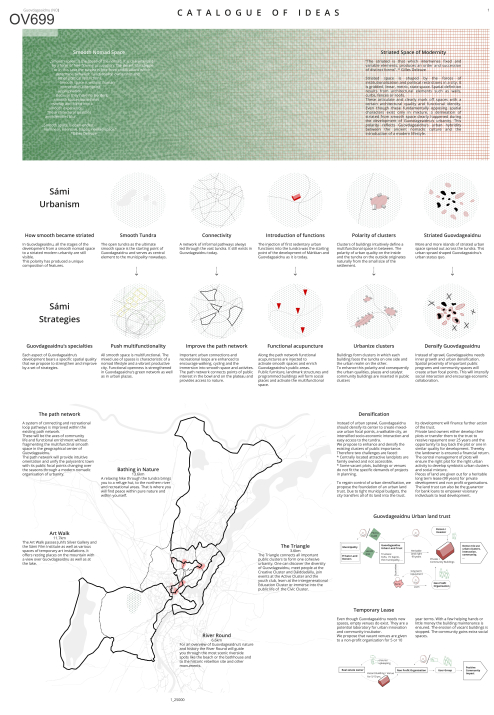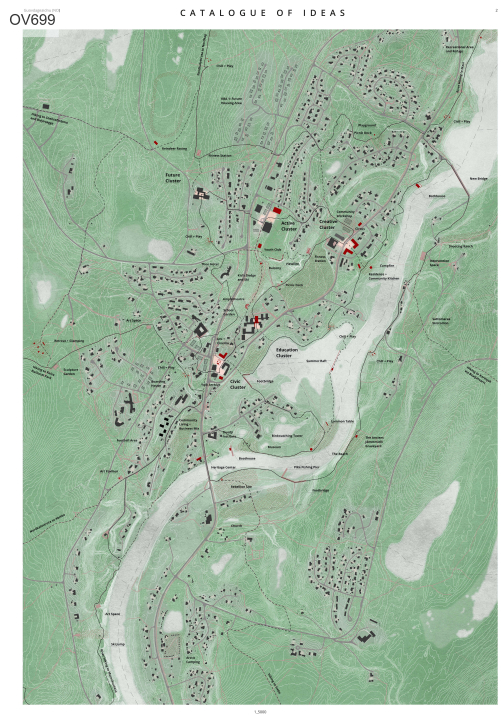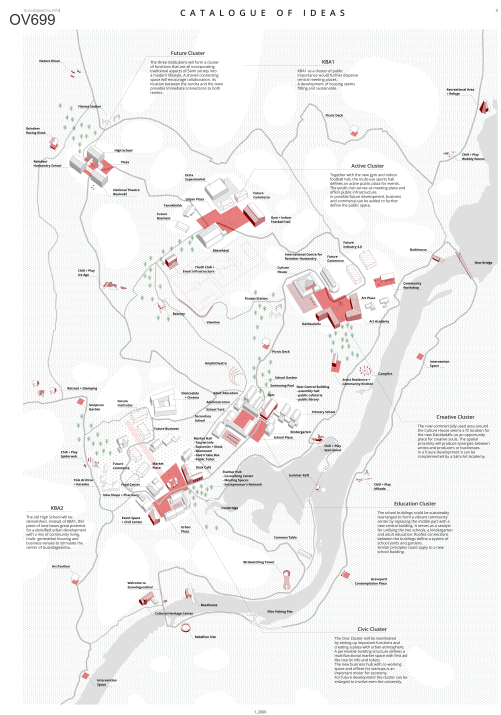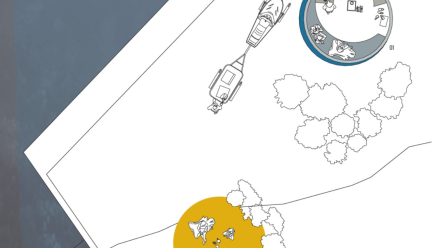Project:
Catalogue of Ideas
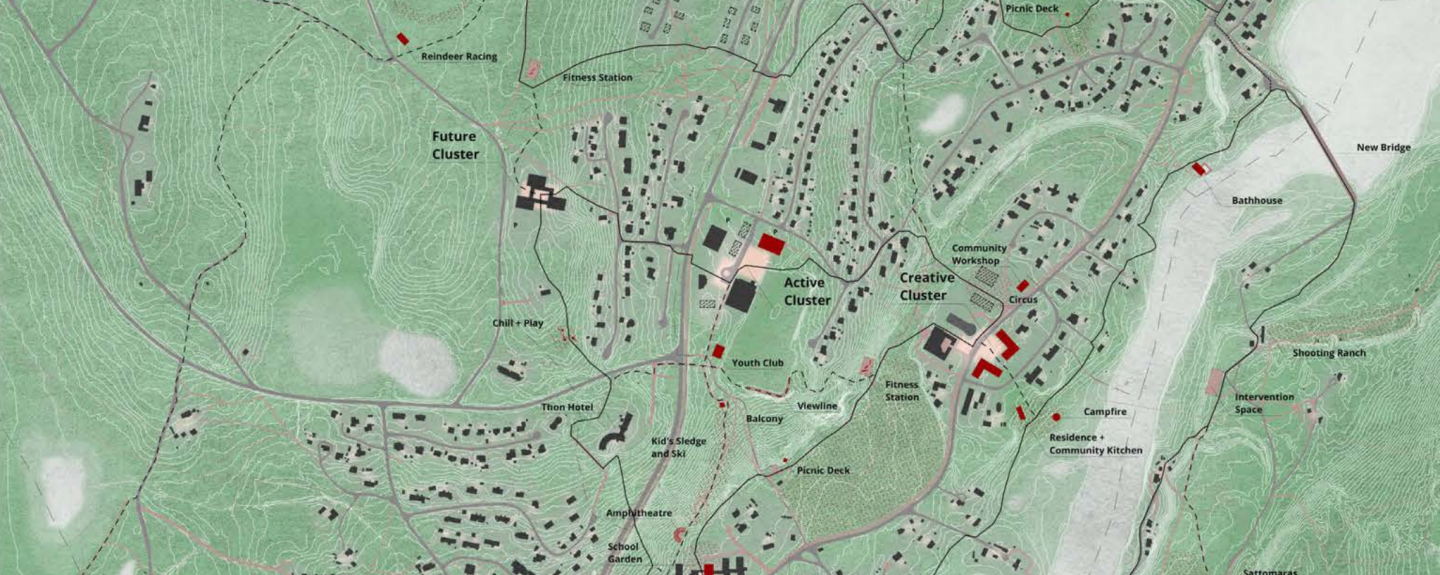
About
-
A major strength of the project is also the recognition of territorial and proprietary challenges and the suggestion of a Land Trust in order to meet the intensified need to coordinate land use development and management. Rich in thoughts and designs and serious in its approach to the complex sites, Catalogue of Ideas presents a solid and inspiring vision for the further development of Guovdageaidnu as a major Sámi cultural and economic center as well as an important destination for travelers.
-
Based on an informed interpretation of Guouvdageaidnu’s development as a hybrid settlement, Catalogue of Ideas presents a very ambitious answer to the challenging call and to the general topic of “The Productive City”. The project interestingly frames the site as having developed or unfolded between the “smooth” space of the tundra and the “striated” space of the modern welfare state. It further elaborates this framing by proposing a set of five strategies for strengthening and articulating
a specific “Sámi urbanism”.While recognizing the specific historical and geographical circumstances and the pertinent presence of the tundra as much more than a backdrop, the project identifies in a very clear way a number of qualities and challenges: landscape pathways as not only recreational but formative, clustering of services as a means of intensification, and the importance of multifunctional and seasonal usage of common amenities.
-
Team Representative: Paul Raphael Schaegner (DE) – architect; Associates: Teresa Timm ( DE) & Merle Jelitto (DE) – architects
Saarwerdenstrasse 19, 40547 Duesseldorf (DE)
+49 1 799 753 758 – temepati@gmail.com – www.prsch.net
M. Jelitto, P. R. Schaegner & T. Timm
Team interview
1. How did you form the team for the competition?
We are friends and we are all currently living in Hamburg. Paul had the idea to do Europan together, as it is a great opportunity to work on a more theoretical project in addition to the daily praxis of an architectural office. So, we decided to form a team.
2. How do you define the main issue of your project, and how did you answer on this session main topic: the place of productive activities within the city?
The main issue was to answer the question of what a city of a contemporary productive Sami community could look like. Guovdageaidnu is a small town in the very far North of Europe. The seasons have a big impact of the daily life as the town changes character during summer and winter. In summer the river represents a barrier, in winter it becomes a highway for snow mobiles. The seasonal impact is only one aspect on how nature is present in town. Furthermore, life with the tundra is strongly culturally rooted. The question of how the city behaves in contrast to nature, or rather life in nature, became essential. We decided to create densified clusters of public functions. They form islands of urbanity surrounded by the smooth landscape of the tundra. Enhancing the contrast of built environment and nature strengthens the inherent qualities of both realms. The connected densified clusters become the important urban and productive focal points, while all parts of the city, and especially housing, still has direct access to nature allowing a contemporary Sami lifestyle.
3. How did this issue and the questions raised by the site mutation meet?
Is the ideal city centre the same all over the world? Would a densified medieval urban structure with a walkable city nucleus like in German cities fit the Sami lifestyle? It first came to our minds, that Guovdageaidnu needs a vibrant productive centre with a colorful mix of functions. But it was quite clear that this wouldn’t be a fitting strategy, so we started searching for something inherent in the site. We found specific structures and forms. The so called “sidas“ are groups of houses surrounding a productive multifunctional yard, always connected to the tundra on the outside. Those pragmatic structures originate in the tradition of a nomadic lifestyle. There was never a lack of space and no need for densification, but a direct access to the tundra was required instead. We realized that the principle of clusters in the tundra could be scaled to a higher level to generate a few interconnected clusters of urban importance and a productive Sami city.
4. Have you treated this issue previously? What were the reference projects that inspired yours?
We haven’t treated this issue previously, at least not in this special context. We had no architectural reference projects, but there is a text from philosopher Gilles Deleuze, which describes two kinds of spaces: The “smooth“ and the “striated“. This bipolar system of spaces became fundamental for our work. During the course of developing the “Catalogue of Ideas”, we found more and more imagery and urban situations resembling both bipolar spaces and their relation.
5. Urban-architectural projects like the ones in Europan can only be implemented together with the actors through a negotiated process and in time. How did you consider this issue in your project?
The task for Guovdageaidnu was broadly formulated and we were searching for an appropriate format to answer it. Our contribution includes a wide range of ideas – hence the name “Catalogue of ideas“. It ranges from economic models, a proposal for a new path network to proposals for built interventions on different scales and different sites in the city. It was important to us to pursue the theoretical idea of the striated urban space and the smooth tundra as much as possible, so that it becomes tangible. But it is not a proposal with a fixed time horizon. This entails many possible scenarios of working together and we are looking forward to discuss those with the people of Guovdageaidnu.
6. Is it the first time you have been awarded a prize at Europan? How could this help you in your professional career?
For Paul, it is the second time being rewarded in Europan. At Europan 14 he was a Runner-up with a different team on the Hamburg site (DE). The recognition of being a winner in Europan is evidently helpful for our professional career. The network of people related to Europan is also very valuable and inspiring.
TEAM IDENTITY
Office: We formed a collaborative team for this project. The Whatsapp working title was Moin Moin.
Functions: All team members studied architecture but are nevertheless interested and skilled in other fields that are part of their work, like urban planning, landscape planning, theoretical research and real estate financial modeling.
Average age of the associates: 31 years old
Has your team, together or separately, already conceived or implemented some projects and/or won any competition? If yes, which ones?
The team has never worked together before. But one team member, Paul Raphael Schaegner, was rewarded as a Runner-up in Europan 14 for his project DA/ -RIN -RUM -RUNTER –ZWISCHEN that he developed with Robert Schnell and Tobias Herr.
Paul Raphael Schaegner’s project “Dreiklang am Inn” was shortlisted at the Europan 15. It was developed for the site in Innsbruck (AT) together with Maria Mahinova and with the help of Kathrin Meyer and Evita Papazisi.
